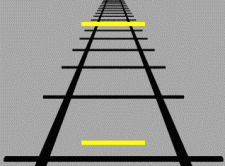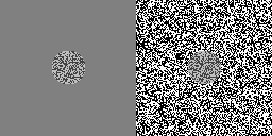Related Research Articles

Perception is the organization, identification, and interpretation of sensory information in order to represent and understand the presented information or environment. All perception involves signals that go through the nervous system, which in turn result from physical or chemical stimulation of the sensory system. Vision involves light striking the retina of the eye; smell is mediated by odor molecules; and hearing involves pressure waves.
An illusion is a distortion of the senses, which can reveal how the mind normally organizes and interprets sensory stimulation. Although illusions distort the human perception of reality, they are generally shared by most people.

In visual perception, an optical illusion is an illusion caused by the visual system and characterized by a visual percept that arguably appears to differ from reality. Illusions come in a wide variety; their categorization is difficult because the underlying cause is often not clear but a classification proposed by Richard Gregory is useful as an orientation. According to that, there are three main classes: physical, physiological, and cognitive illusions, and in each class there are four kinds: Ambiguities, distortions, paradoxes, and fictions. A classical example for a physical distortion would be the apparent bending of a stick half immerged in water; an example for a physiological paradox is the motion aftereffect. An example for a physiological fiction is an afterimage. Three typical cognitive distortions are the Ponzo, Poggendorff, and Müller-Lyer illusion. Physical illusions are caused by the physical environment, e.g. by the optical properties of water. Physiological illusions arise in the eye or the visual pathway, e.g. from the effects of excessive stimulation of a specific receptor type. Cognitive visual illusions are the result of unconscious inferences and are perhaps those most widely known.

The Müller-Lyer illusion is an optical illusion consisting of three stylized arrows. When viewers are asked to place a mark on the figure at the midpoint, they tend to place it more towards the "tail" end. The illusion was devised by Franz Carl Müller-Lyer (1857–1916), a German sociologist, in 1889.

Depth perception is the ability to perceive distance to objects in the world using the visual system and visual perception. It is a major factor in perceiving the world in three dimensions. Depth perception happens primarily due to stereopsis and accommodation of the eye.

An afterimage is an image that continues to appear in the eyes after a period of exposure to the original image. An afterimage may be a normal phenomenon or may be pathological (palinopsia). Illusory palinopsia may be a pathological exaggeration of physiological afterimages. Afterimages occur because photochemical activity in the retina continues even when the eyes are no longer experiencing the original stimulus.

The Ternus illusion, also commonly referred to as the Ternus Effect is an illusion related to human visual perception involving apparent motion. In a simplified explanation of one form of the illusion, two discs, are shown side by side as the first frame in a sequence of three frames. Next a blank frame is presented for a very short, variable duration. In the final frame, two similar discs are then shown in a shifted position. Depending on various factors including the time intervals between frames as well as spacing and layout, observers perceive either element motion, in which L appears to move to R while C remains stationary or they report experiencing group motion, in which L and C appear to move together to C and R. Both element motion and group motion can be observed in animated examples to the right in Figures 1 and 2.

The Moon illusion is an optical illusion which causes the Moon to appear larger near the horizon than it does higher up in the sky. It has been known since ancient times and recorded by various cultures. The explanation of this illusion is still debated.

Ambiguous images or reversible figures are visual forms that create ambiguity by exploiting graphical similarities and other properties of visual system interpretation between two or more distinct image forms. These are famous for inducing the phenomenon of multistable perception. Multistable perception is the occurrence of an image being able to provide multiple, although stable, perceptions.

The term illusory motion, also known as motion illusion, is an optical illusion in which a static image appears to be moving due to the cognitive effects of interacting color contrasts, object shapes, and position. Apparent motion is the most common type of illusory motion and is perceived when images are displayed in succession at a specific frame rate such as in a movie. The concept was allegedly first identified by Aristotle.
Stereopsis is the component of depth perception retrieved through binocular vision. Stereopsis is not the only contributor to depth perception, but it is a major one. Binocular vision happens because each eye receives a different image because they are in slightly different positions on one's head. These positional differences are referred to as "horizontal disparities" or, more generally, "binocular disparities". Disparities are processed in the visual cortex of the brain to yield depth perception. While binocular disparities are naturally present when viewing a real three-dimensional scene with two eyes, they can also be simulated by artificially presenting two different images separately to each eye using a method called stereoscopy. The perception of depth in such cases is also referred to as "stereoscopic depth".

The Ponzo illusion is a geometrical-optical illusion that was first demonstrated by the Italian psychologist Mario Ponzo (1882–1960) in 1913. He suggested that the human mind judges an object's size based on its background. He showed this by drawing two identical lines across a pair of converging lines, similar to railway tracks. The upper line looks longer because we interpret the converging sides according to linear perspective as parallel lines receding into the distance. In this context, we interpret the upper line as though it were farther away, so we see it as longer – a farther object would have to be longer than a nearer one for both to produce retinal images of the same size.

Visual angle is the angle a viewed object subtends at the eye, usually stated in degrees of arc. It also is called the object's angular size.
Subjective constancy or perceptual constancy is the perception of an object or quality as constant even though our sensation of the object changes. While the physical characteristics of an object may not change, in an attempt to deal with the external world, the human perceptual system has mechanisms that adjust to the stimulus.

The lilac chaser is a visual illusion, also known as the Pac-Man illusion. It consists of 12 lilac, blurred discs arranged in a circle, around a small black, central cross on a grey background. One of the discs disappears briefly, then the next, and the next, and so on, in a clockwise direction. When one stares at the cross for at least 30 seconds, one sees three illusions
- A gap running around the circle of lilac discs;
- A green disc running around the circle of lilac discs in place of the gap; and
- The green disc running around on the grey background, with the lilac discs having disappeared in sequence.

The Chubb illusion is an optical illusion or error in visual perception in which the apparent contrast of an object varies substantially to most viewers depending on its relative contrast to the field on which it is displayed. These visual illusions are of particular interest to researchers because they may provide valuable insights in regard to the workings of human visual systems.
Convergence micropsia is a type of micropsia characterized by the reduction in apparent size of objects viewed when the eyes are more converged than they need to be for the distance of the object from the eyes.
In human visual perception, the visual angle, denoted θ, subtended by a viewed object sometimes looks larger or smaller than its actual value. One approach to this phenomenon posits a subjective correlate to the visual angle: the perceived visual angle or perceived angular size. An optical illusion where the physical and subjective angles differ is then called a visual angle illusion or angular size illusion.
Geometrical-optical illusions are visual illusions, also optical illusions, in which the geometrical properties of what is seen differ from those of the corresponding objects in the visual field.

Hans Wallach was a German-American experimental psychologist whose research focused on perception and learning. Although he was trained in the Gestalt psychology tradition, much of his later work explored the adaptability of perceptual systems based on the perceiver's experience, whereas most Gestalt theorists emphasized inherent qualities of stimuli and downplayed the role of experience. Wallach's studies of achromatic surface color laid the groundwork for subsequent theories of lightness constancy, and his work on sound localization elucidated the perceptual processing that underlies stereophonic sound. He was a member of the National Academy of Sciences, a Guggenheim Fellow, and recipient of the Howard Crosby Warren Medal of the Society of Experimental Psychologists.
References
- ↑ Emmert E. (1881) Größenverhältnisse der Nachbilder. Klinische Monatsblätter für Augenheilkunde und für augenärztliche Fortbildung, 19: 443-450.
- ↑ Bonnet, Claude; Pouthas, Viviane (1972). "Apparent Size and Duration of a Movement After-effect". Quarterly Journal of Experimental Psychology. 24 (3): 275–281. doi: 10.1080/14640747208400281 . ISSN 0033-555X. PMID 5049930.
- ↑ Fisher, Gerald H. (1968). "Illusions and Size-Constancy". The American Journal of Psychology. 81 (1): 2–20. doi:10.2307/1420801. ISSN 0002-9556. JSTOR 1420801.
- ↑ Epstein W, Park J, Casey A. (1961) The current status of the size-distance hypotheses. Psychological Bulletin, 58: 491-514.
- 1 2 Dwyer, J.; Ashton, R.; Broerse, J. (1990). "Emmert's law in the Ames room". Perception. 19 (1): 35–41. doi:10.1068/p190035. ISSN 0301-0066. PMID 2336333. S2CID 8110144.
- ↑ Lou L. (2007) Apparent afterimage size, Emmert’s law, and oculomotor adjustment. Perception,36:1214-1228.
- ↑ Ross H E, Plug C. (2002) The mystery of the moon illusion: Exploring size perception. Oxford: Oxford University Press.
- ↑ Gregory R L. (2008) Emmert’s Law and the moon illusion. Spatial Vision, 21: 407-420.
- ↑ Sperandio I, Chouinard PA, Goodale MA (2012). "Retinotopic activity in V1 reflects the perceived and not the retinal size of an afterimage". Nat. Neurosci. 15 (4): 540–2. doi:10.1038/nn.3069. PMID 22406550. S2CID 205434328.
- ↑ Kaufman, L; Vassiliades, V; Noble, R; Alexander, R; Kaufman, J; Edlund, S (2007). "Perceptual distance and the moon illusion". Spatial Vision. 20 (1): 155–175. doi:10.1163/156856807779369698. PMID 17357720. S2CID 11812239.